New day for the Delaware
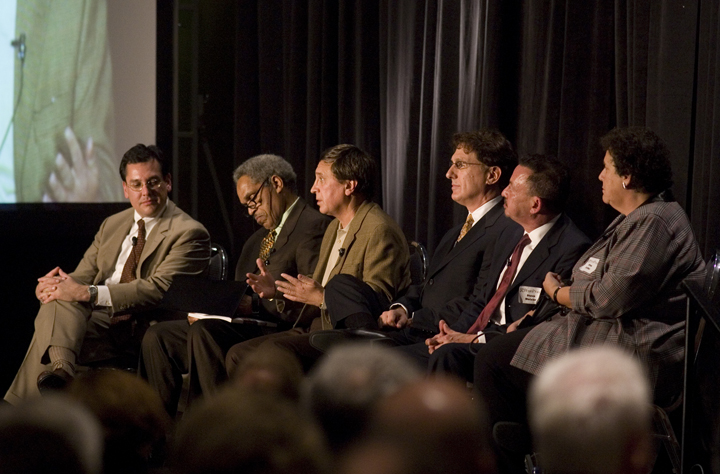
Nov. 14
By Alan Jaffe
For PlanPhilly
A new vision for the Central Delaware waterfront, forged over 13 months in more than 200 collaborative, occasionally contentious civic meetings, was formally introduced last night with dramatic flare and some compromise on the most disputed elements.
Inquirer coverage
Metro coverage
Daily Pennsylvanian
The proposal to bury a section of I-95 was softened by less drastic options. The dense riverfront street grid was proposed with a nod toward developers’ concerns. And the casinos, the hottest issue, were plotted on the plan – and then dissolved on an alternative map.
The audience of about 1,200 at the Pennsylvania Convention Center cheered the proposals and offered a standing ovation to the concluding video fly-over, a time-warp that transformed the current waterfront into an active, thriving scene of green spaces and well-balanced development and communities.
Approval for the plan, which was coordinated by PennPraxis, the clinical arm of the design department at the University of Pennsylvania, came from nearly every front. Mayor Street lauded the process for engaging the river ward communities and taking on a challenge that has eluded the city for decades. Michael DiBerardinis, secretary of the state Department of Conservation and Natural Resources, called the Civic Vision “meaningful and important.” Riverfront developer Bart Blatstein said the plan is “a great start.”
Dissenting voices in the audience condemned any allowance for casinos, intermittently disrupting the presentation by PennPraxis executive director Harris Steinberg, who has guided the Civic Vision through several combative meetings. Outside the Convention Center, a six-foot skunk urged people to wear clothespins to show their displeasure with the Foxwoods and SugarHouse sites.
A panel of government, business and community leaders were invited to respond to the presentation, and they lent their support to most aspects of the plan. But there was a clash over the issue of funding a major I-95 reconfiguration. Rina Cutler, deputy secretary at PennDot, warned that an estimated $10 billion needed to depress the interstate at Penn’s Landing would be hard, if not impossible, to raise. Mayor Street disagreed. Initial response to large projects is always negative, Street said, but “there is plenty of money” if the public says “this is the priority.”
Overall, the evening was upbeat, congratulatory, and very hopeful.
Councilman Frank DiCicco, whose constituents’ fears of waterfront gaming sparked his suggestion that the city create a master plan for the Central Delaware, said the unveiling last night was “the highlight of my political career.” He thanked the William Penn Foundation for providing more than $1.6 million for this first phase of the waterfront process. He also credited Street for signing the executive order in October 2006 that charged PennPraxis with leading the effort.
The mayor noted that “plan after plan failed” to make the best use of the 13-acre parcel on the Center City riverfront. “The thing that should distinguish this report from other studies is you,” he told the audience last night. “We never had this kind of community engagement” in the process before, and “what will deter it from sitting on a shelf is you not letting it happen.”
With just over 50 days left in his term, he urged that the plan more forward with the formation of an organization that will take up the banner and “ensure that this work has not been done in vain.”
Steinberg then took the podium to present the culmination of his team’s year-long labor in an eloquent, 30-minute sales pitch. With archival, contemporary and conceptual images of the waterfront beamed on two screens flanking him, and on screens in an adjoining hall for the overflow crowd, Steinberg emphasized the historical and regional context of the Central Delaware — from William Penn’s arrival, through the riverfront’s industrial dominance, through the traffic-jammed state of things today. The initial question was, “how do we create a framework for growth?” he said.
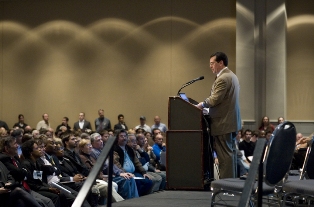
PennPraxis conferred with elected officials and every civic group with a stake in the waterfront so that the “pinheads from Penn,” as he heard one resident describe his team, “would not impose their image on the waterfront.”
The planners relied on the values expressed by residents in that series of meetings, and on the best practices for riverfront redevelopment accomplished in Chicago, New York, San Francisco, Milwaukee and Hoboken. “Man, if we can’t beat Hoboken,” Steinberg laughed.
What the Philadelphia team came up with was three frameworks based on movement, open space, and development.
Movement refers to connections across and beneath I-95 to the river, a street grid that replicates the feeling of Center City life on the waterfront, and a north-south urban boulevard.
A reborn Delaware Boulevard, the “spine” of the riverfront, would mean keeping a six-lane avenue for now, but eventually “skinnying up” the current road to allow for a light-rail or other mass transit line down the center.
The street grid would recall the 17th-century template designed by William Penn “which has guided our identity,” Steinberg said. “We need to think about extending that to the river,” not only to disperse traffic, but also as “the connective tissue” that links land parcels.
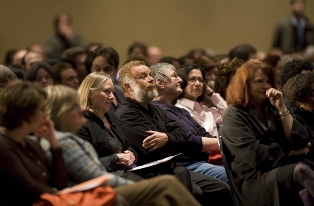
The audience applauded the Civic Plan’s suggestion that Septa and Patco lines be linked on a reinvented waterfront. Water ferries and water taxis are also part of the plan, as opposed to a Camden-Philadelphia tram that links the two cities.
Turning to the high-profile proposal of burying I-95 to reclaim the Penn’s Landing area, Steinberg offered a conciliatory tone. “Is there a way to sink it? I don’t know. There is lots more study to be done. It is something that the plan doesn’t live or die on.
“But if we don’t start thinking about it,” he said, “Philadelphia will miss the boat to capitalize on that potential.”
The open space framework in the Civic Vision foresees “a great lawn” at Penn’s Landing, “a great democratizing element of the city.”
Frankford Avenue and Spring Garden Streets were presented in artist’s drawings transformed into pedestrian-friendly green streets of trees, blooming medians, and bike lanes. The string of parks and open spaces along the Delaware would “do work,” Steinberg said, filtering stormwater and pollutants, and creating wetlands, wildlife habitats, tidal gardens, and a healthier city and river.
Land development along the water, and specifically how casinos fit into the plan, has been “the most contentious part of this project,” Steinberg said,
“Not an option!” an audience member shouted.
“Yes it is!” responded another.
“Bull—-!” answered the first.
Acknowledging the debate, PennPraxis provided two options for those sites on the waterfront plan, with and without the casinos. But Steinberg said the issue is “not about what is there. It’s about how the buildings relate to each other” and surrounding streets, and whether they allow access to the waterfront.
Other development issues should be addressed through zoning code reforms, according to the Civic Vision. The street grid plan must be codified and buildings must “meet the street line,” with retail, commercial and “life-affirming” uses, Steinberg said. Tall buildings should be staggered along the landscape to ensure “everyone has light and air and views of the river,” he also said.
There is a place on the river for big-box development, too, so long as it is “done more gracefully,” Steinberg said.
The presentation ended with the video, reminiscent of the 1964 World’s Fair ride that looked ahead to the city of the future. The audience was remarkably silent as it was given a glimpse of what Philadelphia could become 50 years from now. When it ended, they rose and applauded the vision.
In an official response to the plan, DCNR secretary DiBerardinis, a 30-year resident of Fishtown, said the unveiling of the plan was an “important event for Philadelphia.”
A century ago, he said, Pennsylvania stood at a similar crossroads, with its forests decimated and streams polluted by the Industrial Revolution. But some leaders had a vision for the commonwealth that helped save its ecosystems. “We are in a similar moment in this time,” he said. Conservation and sustainable communities will become policy imperatives, and “cities that imagine a waterfront like this are the ones that will succeed,” DiBerardinis said.
“The plan is right. The economy of the future will be built around efficiency and sustainability,” he said.
To make it happen, the city must build on the collaboration of the community, DiBerardinis continued. There must be consistent city leadership to shepherd the plan forward, and it must move from a vision to a detailed planning process. Strategic investment must be made and leveraged through the local, state and federal governments, he said. And “early victories” should be implemented “so people can see the reality.”
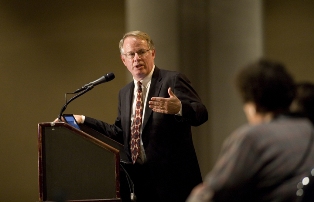
Inquirer columnist Chris Satullo moderated the panel discussion that ended the evening, posing his own questions and those from the audience.
Blatstein, of Tower Investments, said “planning is not the enemy. The enemy is lack of planning.” He said the Civic Vision has been a “marriage of planners, developers and communities.”
Blatstein also said there should be no gated communities along the waterfront and there should be open and free access to the river.
Cutler, of PennDot, who was among the supervisors on Boston’s Big Dig project, said Philadelphia should not become too focused on a large I-95 reconstruction. “If we spend years debating if it is possible to bury 95, we will miss the opportunity to rethink what else exists there.”
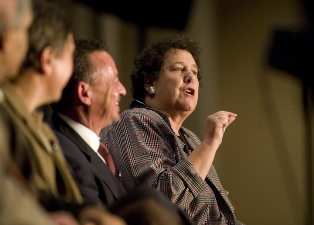
A better choice, she said, might be improved public transit on the waterfront. Because of funding limitations, “we may have to make those choices,” she said.
Mayor Street said an ambitious 95 redo can happen. “It will not happen unless we say this is the kind of investment we want from the local and federal government,” he said. That will require the support of surrounding counties, who must also see that a revived city waterfront will benefit their residents. “The biggest deterrent is perceived regional differences,” he said.
Steinberg said the next steps in the process will be “early action projects,” such as the blazing of a bike trail from the Pier 70 neighborhood to Penn’s Landing, the restoration of riverfront wetlands, and the release of an implementation guide in the spring.
“This is the very beginning,” he said.
Alan Jaffe is a former Philadelphia Inquirer editor. He can be contacted at alanjaffe@mac.com
WHYY is your source for fact-based, in-depth journalism and information. As a nonprofit organization, we rely on financial support from readers like you. Please give today.



